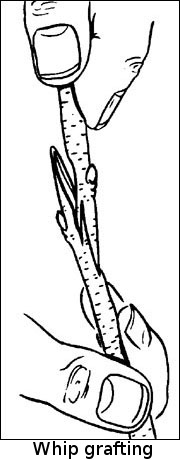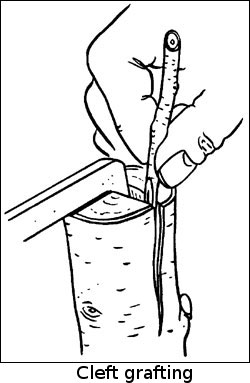
Topworking changes mature fruit trees to new varieties
 Sometimes, I'm amazed how knowing
the right word
opens research doors that have been slamming in your face. I've
been
tossing around the idea of grafting
new varieties onto my four year old
pear trees, but
before I undertook such a major surgery, I wanted to hear from
people who had tried the same experiment successfully.
Unfortunately,
my internet searches turned up very little information...until I
stumbled across the term "topwork".
Sometimes, I'm amazed how knowing
the right word
opens research doors that have been slamming in your face. I've
been
tossing around the idea of grafting
new varieties onto my four year old
pear trees, but
before I undertook such a major surgery, I wanted to hear from
people who had tried the same experiment successfully.
Unfortunately,
my internet searches turned up very little information...until I
stumbled across the term "topwork".
Topworking is the method
that orchardists use to change one tree variety to another. If
your trees (like mine) are pretty small (less than three inches trunk
diameter), you can simply take a deep breath and cut the whole top off
the tree below the first tier of branches and graft your new variety
there. Otherwise, you'll need to graft six to ten limbs that will
be the tree's main scaffolds. If your tree is more than eight
years old, it's probably so big that you should spread your topworking
out across two or more years, but otherwise you can do the deed all at
once.
How do you perform this
high stakes grafting? I'm most familiar with whip grafts that you
use to graft scionwood onto rootstock, but whip grafts are only
appropriate if both pieces of tree being grafted are roughly the same
diameter. In topworking, you generally have a pencil-thin piece
of scionwood being grafted onto a  much larger branch or trunk,
so you'll want to choose between budding, cleft grafting, and bark
grafting.
much larger branch or trunk,
so you'll want to choose between budding, cleft grafting, and bark
grafting.
Budding is most
appropriate for cherries, plums and peaches, while apples and pears
respond well to other types of grafts. The choice between cleft
and bark grafts depends upon time of year, with cleft grafting working
best just as buds begin to swell while bark grafting comes later in the
year when bark begins to slip. (The photos in this post are from
the Missouri Extension
Service website,
which also gives more in depth information about each kind of graft.)
I've decided to perform
one cleft graft on each of my pear trees, lopping off the tree top and
then inserting two pieces of scionwood in each. The double
scionwood is a way of hedging my bets --- I'll cut one off next year if
both take hold. Stay tuned for photos once I have scionwood in
hand and am ready to take the plunge!
Want more in-depth information? Browse through our books.
Or explore more posts by date or by subject.
About us: Anna Hess and Mark Hamilton spent over a decade living self-sufficiently in the mountains of Virginia before moving north to start over from scratch in the foothills of Ohio. They've experimented with permaculture, no-till gardening, trailersteading, home-based microbusinesses and much more, writing about their adventures in both blogs and books.
Want to be notified when new comments are posted on this page? Click on the RSS button after you add a comment to subscribe to the comment feed, or simply check the box beside "email replies to me" while writing your comment.

Charity --- It sounds like you've got quite an experimental time ahead of you! Are you just trying to identify the species of each rootstock? That should be pretty easy. Of the species with more rounded leaves, pear leaves are smooth, apples fuzzy underneath. Peach leaves are very long and slender, and cherry leaves look a bit like the halfway house between a peach and a pear.
If you do a google image search for "pear leaf", etc., you'll see the differences pretty quickly.
what perfect timing for this post. I've moved to a new place that has some established wild plums that I've been thinking of grafting some plum varieties onto.
On another note...I've been reading about "gritty mix" for growing citrus in...have you ever experimented with that?
Naomi AKA Fostermamas
Fostermamas --- Glad I got you thinking! I probably could have tried to graft onto my wild plum, but it was so big, it would have been a huge undertaking. And I didn't even think of it until you commented!
I'd never heard of "gritty mix" for citrus. I did a little bit of internet research, and it sounds like the purpose of gritty mix is to make sure the soil for a potted plant doesn't get compacted and end up anaerobic, especially if you don't repot for more than two years in a row. I've never had a problem with my stump dirt/manure compost combo losing its fluff for my fruit trees, but I'll be curious to hear how your gritty mix works. Here's the best site I found about it: http://www.etenix.com/index.php?option=com_content&view=article&id=1&Itemid=6
Time to practice your mad scientist laugh.
I am excited to see how your experiment turns out - please take a lot of pictures of your process. As a woodworker it is making my brain go Boing Boing Boing. I just have never thought of performing 'joinery' on a live tree at the scale pictured in that 2nd illustration.